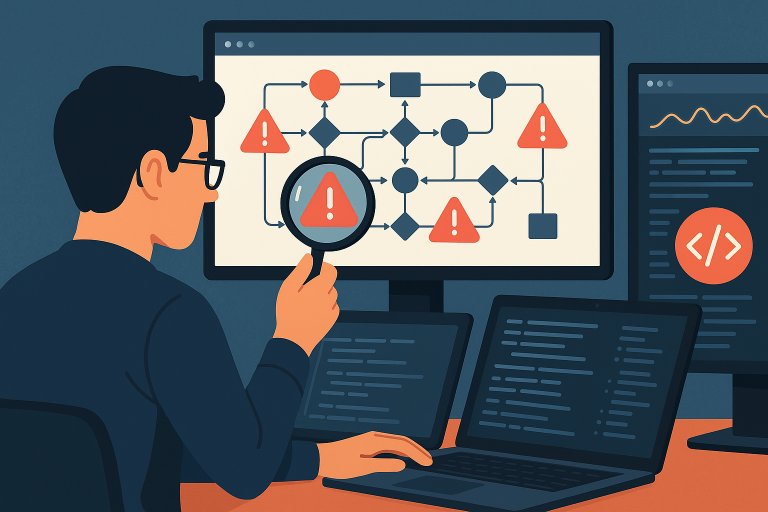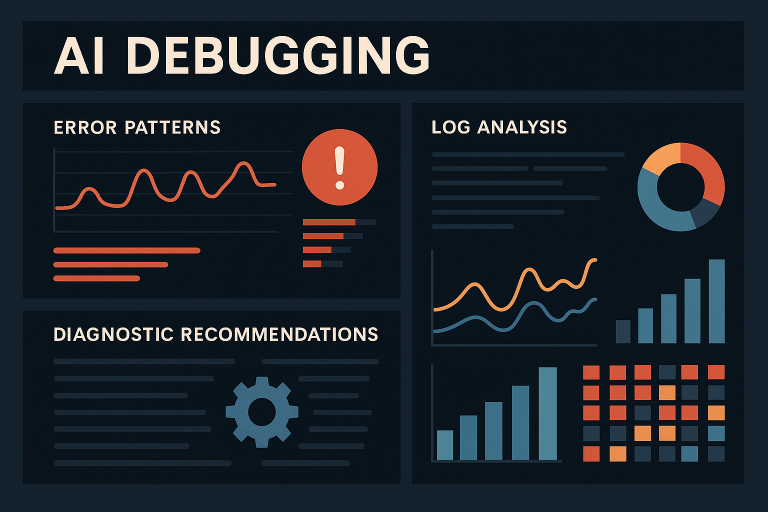Complete Guide to Debugging AI Workflows Efficiently
Artificial intelligence workflows are complex systems with many moving parts—from data preprocessing to model deployment and monitoring. When something goes wrong, finding and fixing the issue can feel like searching for a needle in a digital haystack. Yet, effective debugging is what separates robust AI implementations from fragile ones that fail in production.
In this comprehensive guide, we’ll explore how to identify, diagnose, and automatically resolve errors in your AI workflows, helping you build more reliable machine learning systems while saving precious development time.

Understanding AI Workflow Errors
Before you can fix what’s broken, you need to understand what can break. AI workflows face unique challenges compared to traditional software systems due to their statistical nature and reliance on data quality.
Types of AI Workflow Errors
AI workflow errors can manifest at various stages of the machine learning lifecycle. Recognizing these error patterns is the first step toward effective debugging:
- Data-related errors: Missing values, outliers, inconsistent formatting, or schema changes that weren’t accounted for
- Model training failures: Convergence issues, exploding/vanishing gradients, or hardware resource limitations
- Pipeline integration issues: Incompatible data formats between components, version mismatches, or API changes
- Deployment complications: Environment inconsistencies, scaling problems, or resource allocation issues
- Performance degradation patterns: Data drift, concept drift, or unexpected edge cases not covered in training
Each of these error categories requires different debugging approaches and tools, making comprehensive debugging knowledge essential for AI engineers.
Impact of Undetected Errors
The stakes are high when AI workflows fail silently. Undetected errors can lead to:
| Error Impact | Consequence | Business Risk |
|---|---|---|
| Model bias reinforcement | Amplification of unfair patterns in decisions | Reputational damage, legal liability |
| Performance degradation | Gradual decline in prediction accuracy | Customer dissatisfaction, revenue loss |
| Resource waste | Computing resources spent on broken workflows | Increased operational costs |
| Business impact | Incorrect decisions based on faulty outputs | Strategic missteps, missed opportunities |
| User trust issues | Loss of confidence in AI-powered tools | Adoption challenges, project abandonment |
This is why automated monitoring and debugging systems are not luxuries but necessities in production AI systems.
Automated Error Detection Techniques
The best debugging strategy is one that catches issues before users do. Implementing automated detection systems helps identify problems early, often before they impact your production environment.
Monitoring Frameworks for ML Pipelines
Effective monitoring is your first line of defense against AI workflow failures:
- Real-time performance monitoring: Track key metrics like accuracy, latency, and throughput continuously
- Data drift detection: Automatically flag when input distributions change significantly from training data
- Resource utilization tracking: Monitor CPU, memory, and GPU usage to detect bottlenecks and inefficiencies
- Output validation systems: Implement guardrails that verify AI outputs against business rules and expected patterns
- Alert configuration: Set up meaningful thresholds and notification systems that balance sensitivity with noise reduction
The most effective monitoring systems create a holistic view of your AI workflow, connecting data quality, model performance, and business impact metrics.
Automated Testing for AI Workflows
Just as with traditional software, testing is critical for AI workflows—though it requires specialized approaches:
- Unit testing for ML components: Verify individual transformations, feature engineering steps, and model operations
- Integration testing strategies: Ensure components work together correctly across the pipeline
- Regression testing approaches: Confirm that new changes don’t break existing functionality or performance
- Validation dataset creation: Build comprehensive test suites that cover edge cases and challenging scenarios
- Test-driven development for AI: Define expected behaviors and performance thresholds before implementation
By automating your testing processes, you can continuously validate your AI workflows against a variety of scenarios, catching issues before deployment.
Diagnostic Approaches for AI Workflow Issues
When automated monitoring detects a problem, systematic diagnostic approaches help pinpoint the root cause efficiently.
Tracing and Logging Best Practices
Effective logging is the backbone of AI workflow debugging:
- Structured logging techniques: Use consistent, parseable log formats that include timestamps, component IDs, and severity levels
- Distributed tracing implementation: Track requests as they flow through various services and components
- Log aggregation strategies: Centralize logs from all components for holistic analysis
- Pattern detection in logs: Implement automated tools that can identify unusual patterns or error clusters
- Visualization of error patterns: Create dashboards that highlight temporal or causal relationships between events
“The difference between a debugging nightmare and a quick fix often comes down to the quality of your logging strategy. Invest in good observability upfront, and you’ll save countless hours of detective work later.”
Root Cause Analysis Frameworks
When faced with an AI workflow issue, a systematic approach to root cause analysis can dramatically reduce time-to-resolution:
- Systematic debugging methodology: Follow a step-by-step process to narrow down possible causes
- Fault isolation techniques: Use binary search approaches to identify which component is failing
- Automated diagnosis tools: Leverage specialized software that can suggest likely causes based on symptoms
- Version comparison strategies: Analyze differences between working and non-working versions of models or data
- Collaborative troubleshooting: Implement processes for involving the right experts at the right time
The most efficient debugging teams combine human expertise with automated tools to quickly move from symptom detection to root cause identification.

Automated Debugging Tools
The right tools can dramatically accelerate your debugging workflow and provide insights that would be difficult to discover manually.
Open Source Debugging Tools
Several powerful open-source tools have emerged to address the unique challenges of AI workflow debugging:
- TensorBoard for visualization: Visualize model architecture, training metrics, and parameter distributions
- MLflow for experiment tracking: Compare runs, track hyperparameters, and manage model versions
- Great Expectations for data validation: Define and verify data quality expectations across your pipeline
- Kubeflow pipelines debugging: Analyze and troubleshoot machine learning workflows running on Kubernetes
- Framework-specific debuggers: Utilize specialized tools for PyTorch, TensorFlow, and other frameworks
These tools often provide complementary capabilities, and many teams use several in combination for comprehensive debugging coverage.
Enterprise AI Debugging Platforms
For organizations with more complex needs or larger AI deployments, enterprise platforms offer integrated solutions:
| Platform Category | Key Capabilities | Best For |
|---|---|---|
| End-to-end monitoring solutions | Unified monitoring across data, models, and business metrics | Organizations with diverse AI applications |
| Cloud provider debugging services | Native integration with cloud AI services and infrastructure | Teams heavily invested in a particular cloud ecosystem |
| AutoML debugging capabilities | Automated detection and resolution of common issues | Organizations seeking to democratize AI development |
| CI/CD integration for ML | Testing and validation as part of deployment pipelines | Teams with mature DevOps practices |
| Collaborative debugging environments | Tools for teams to diagnose issues together | Large, distributed AI engineering teams |
When selecting an enterprise platform, consider not just current needs but future scalability requirements as your AI initiatives grow.
Implementing Self-Healing AI Workflows
The ultimate goal of sophisticated AI debugging is creating systems that can detect and resolve common issues automatically, minimizing human intervention.
Automated Error Recovery Patterns
Self-healing AI workflows incorporate automated recovery mechanisms:
- Fallback model strategies: Automatically switch to stable backup models when primary models fail
- Automatic retraining triggers: Initiate model retraining when performance metrics drop below thresholds
- Error-specific recovery actions: Implement targeted responses for different error types
- Circuit breakers for AI pipelines: Temporarily disable components that are failing repeatedly
- Graceful degradation mechanisms: Maintain core functionality even when optimal performance isn’t possible
These patterns allow AI systems to maintain availability and quality even when facing unexpected challenges, much like self-optimizing systems in other domains.
Building Resilient ML Systems
Resilience goes beyond recovery to embrace design principles that anticipate and mitigate potential failures:
- Redundancy strategies: Implement parallel components that can take over when primary systems fail
- Chaos engineering for ML: Deliberately introduce failures to test recovery mechanisms
- Continuous validation approaches: Constantly verify model outputs against ground truth or business rules
- Feedback loops for improvement: Use error patterns to automatically improve training data and model architecture
- Learning from failure patterns: Analyze historical incidents to prevent similar issues in the future
Organizations with truly resilient AI systems view failures not as emergencies but as valuable learning opportunities that ultimately strengthen their systems.
Debugging Case Studies
Examining real-world debugging scenarios provides practical insights into applying these techniques effectively.
Production Model Performance Degradation
A financial services company noticed their fraud detection model’s precision declining gradually over several weeks. Here’s how they addressed it:
- Detection methods used: Automated daily performance monitoring had flagged a 15% drop in precision while maintaining recall
- Diagnostic process: Log analysis revealed increasing false positives in specific transaction categories
- Root cause identification: A major retail partner had changed their transaction coding system, causing legitimate transactions to trigger fraud signals
- Resolution approach: Implemented automated feature transformation for the partner’s transactions and retrained the model
- Preventative measures implemented: Added data schema validation and partner communication protocols to catch similar issues earlier
This case illustrates the importance of continuous monitoring and systematic diagnostic approaches in maintaining model performance.
Data Pipeline Failure Recovery
An e-commerce recommendation engine stopped updating for 72 hours before being detected. The team implemented these debugging measures:
- Error manifestation: Outdated product recommendations leading to poor conversion rates
- Impact assessment: Estimated 5% revenue loss during the affected period
- Debugging techniques applied: Distributed tracing revealed a dependency failure in the data ingestion microservice
- Automation implemented: Deployed circuit breakers, health checks, and automated fallback to previously verified recommendation data
- Lessons learned: Implemented comprehensive dependency monitoring and business impact alerting
This example highlights how automated recovery mechanisms can minimize business impact when failures inevitably occur.
Conclusion: Building a Debugging Culture
Effective AI workflow debugging isn’t merely about tools and techniques—it’s about fostering an organizational culture that values observability, resilience, and continuous improvement.
By implementing the automated detection, diagnosis, and recovery approaches outlined in this guide, you can build AI systems that aren’t just powerful but also reliable in real-world conditions. Remember that the most successful AI teams don’t just fix problems when they occur; they systematically learn from each incident to prevent similar issues in the future.
Start small by implementing basic monitoring and gradually build toward more sophisticated self-healing systems. With each step, you’ll gain confidence in your AI workflows and deliver more value to your users and organization.
What’s your biggest AI debugging challenge? Share in the comments below, and let’s build more reliable AI systems together.
